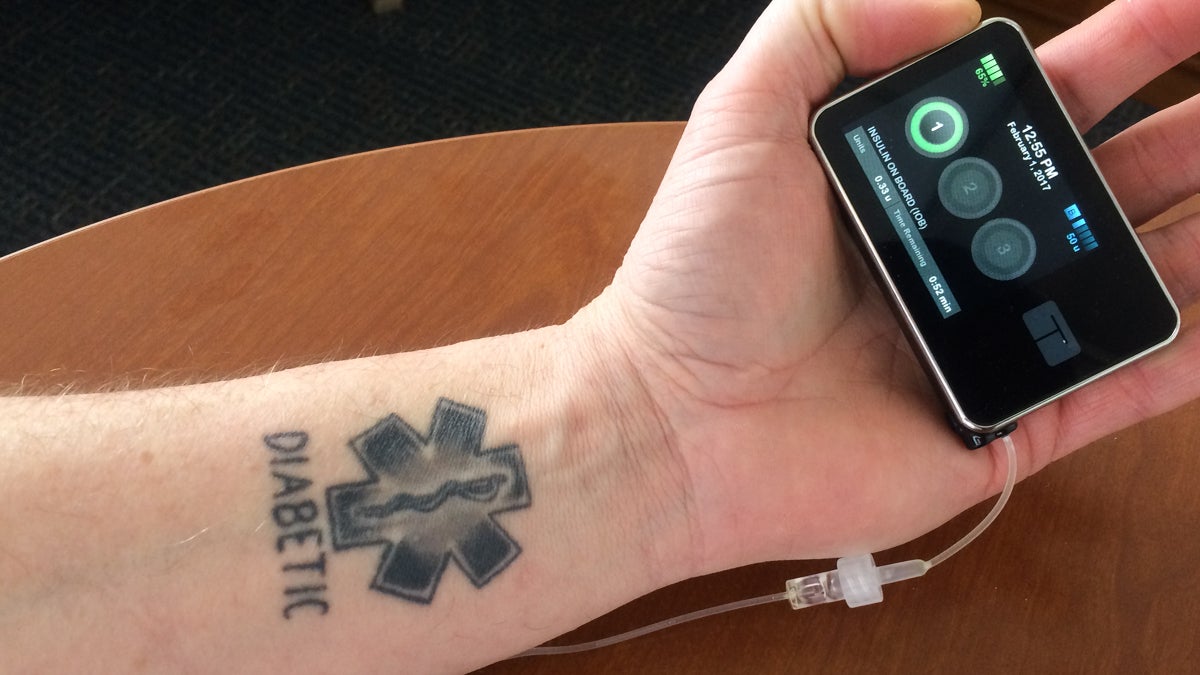Artificial pancreas could mean “freedom” for diabetic patients
Listen
Justin Wood, who has Type 1 diabetes, tested an experimental artificial pancreas. (Alan Yu/ WHYY)
For years, people have been frustrated with the slow pace of innovation in diabetes care. About one million Americans have Type 1 diabetes and many of them have to monitor blood sugar and inject insulin several times a day.
One night 15 years ago, Justin Wood—who has Type 1 diabetes–had plans to get dinner with friends at an Italian restaurant. Anticipating a carb-heavy dinner with pasta and bread, he gave himself a little extra of his daily medicine—insulin–to help break down the meal.
When the dinner was canceled, Wood’s blood sugar plummeted, and he wound up in the emergency room.
“My roommate and my girlfriend at the time were feeding me candy and brownies and they were getting me all kinds of food, and I still passed out,” he said.
Wood is now 45, and has been living with Type 1 diabetes since he was 12. Ever since, he’s needed insulin to stay healthy.
Normally, an organ just behind the stomach called the pancreas makes insulin, a hormone–or protein messenger–that helps blood sugar move into cells so it can be used for energy.
Wood’s pancreas doesn’t make insulin, so he uses a pump to manage the right dose of medicine. When he lifts his shirt, you can see a clear plastic tube leading from the insulin pump directly into Justin’s body. He enters the number of grams of carbs he plans to eat, and then the pump sends the medicine into the fat under the skin. After that, he can enjoy a meal.
He also checks his blood sugar regularly by pricking his fingers with a needle six to eight times a day.
“My fingers look like I have Braille bits from the scabs and scars from checking my blood sugar all the time,” Wood said. “There are small areas that just are darker.”
Wood’s condition is serious enough that he has the word “diabetic” tattooed on his left forearm in black capital letters. It’s a warning to emergency personnel in case something goes wrong.
Keeping blood sugar at healthy levels may soon get easier. Researchers at the University of Virginia have made an artificial pancreas, essentially a smart insulin pump connected to a continuous blood sugar monitor and a smartphone app. The new medical device keeps track of sugar levels and tells the pump when to inject insulin—and could relieve some mental strain.
“It’ll be an amazing bit of freedom for Type 1 diabetics,” Wood said.
Last year, the U.S. Food and Drug Administration approved one such device from the Medtronic company, which will be available this spring.
Wood tested the experimental artificial pancreas from the University of Virginia a few years ago. He was part of a clinical trial, and researchers hosted him and other patients in a hotel for about two days and watched.
“So at one point they simply put a meal in front of me and said, ‘OK, go ahead and eat,'” Wood said. “Well I haven’t done that since I was 13 years old, it was a very strange moment for me.”
For a while, he just looked the plate of chicken and steamed vegetables and brown rice.
“It took me about 10 minutes to work myself up to just eating,” he said.
The artificial pancreas measured his blood sugar levels as he ate and injected insulin, as he needed it.
Wood had gotten so used to having to do that himself; he was unnerved.
“This was … a positive situation that was kind of amusing in the discomfort it gave me because it went against all of these habits that I have … spent years developing to keep myself okay.”
Stacey Anderson, medical director of University of Virginia’s Center for Diabetes Technology, says the device could also be a relief for parents of children with diabetes. She says parents get nervous about their child’s blood sugar dipping too low or spiking too high overnight.
“People tell us they’ll check their sugar before bed, and then wake up religiously at three in the morning and check another sugar, and then check when they wake up in the morning,” she said. “It’s a real lifesaver and a sleep saver for a lot of people.”
In short tests of the device, Anderson says the artificial pancreas has helped patients keep their blood sugar levels healthy by reducing low blood sugar and improving time with normal sugar levels.
Anderson’s team tested the artificial pancreas on teenagers with diabetes, knowing that active, busy young people sometimes forget or misjudge insulin injections. In the study published in 2014, the teenagers got a snack, but skipped their usual, manual insulin injection, letting the artificial pancreas respond to the surge in sugar, and it was partly able to compensate.
“The situation of the blood sugars were much improved compared to what they normally would be, but obviously they’re not completely normal,” Anderson said.
Anderson said the artificial pancreas won’t do everything; people who use the device will still need to program insulin injections before each meal. But if the calculation is off, the artificial pancreas is designed to help correct the dose after the meal.
Patients will also still need occasional finger pricks to calibrate the continuous blood sugar monitor.
The University of Virginia researchers hope to release their device in two to three years. For now the next step is to test the artificial pancreas to further examine how effective and safe it is. In an upcoming clinical trial people with diabetes will take the device home and try it out on all the food and habits in their real lives–including big Italian meals.
Beyond the device from the University of Virginia, there are at least three other artificial pancreas research projects in development.
WHYY is your source for fact-based, in-depth journalism and information. As a nonprofit organization, we rely on financial support from readers like you. Please give today.







